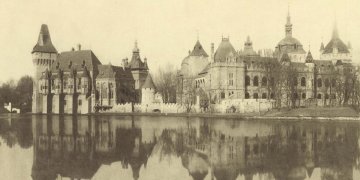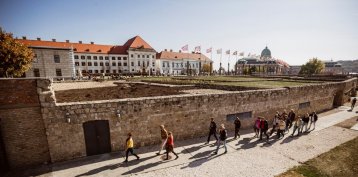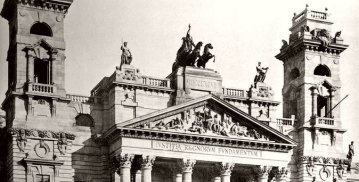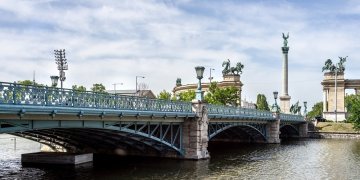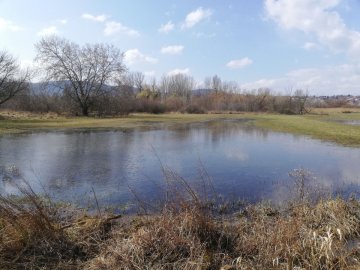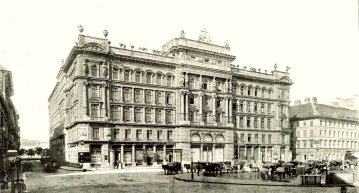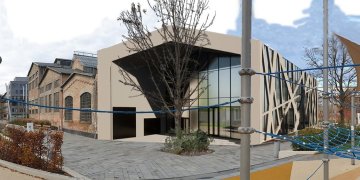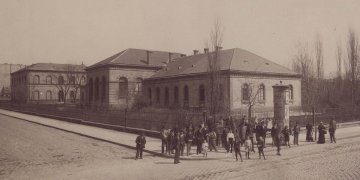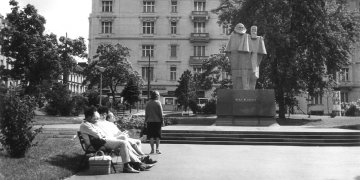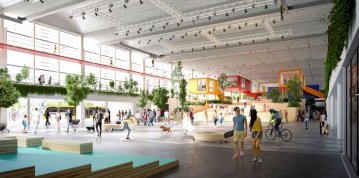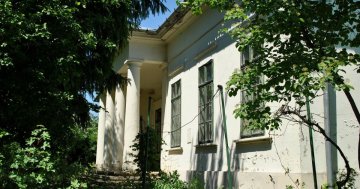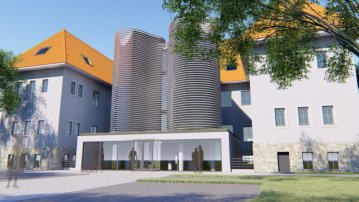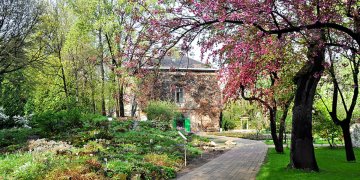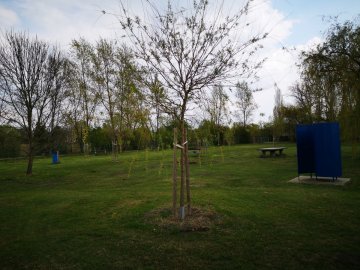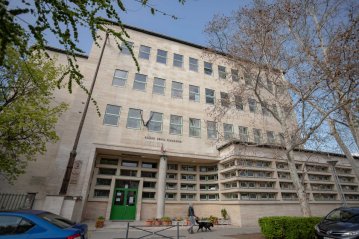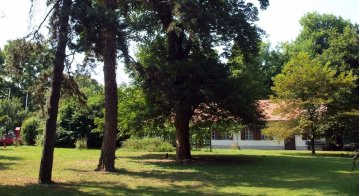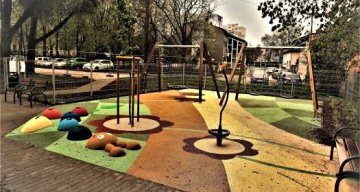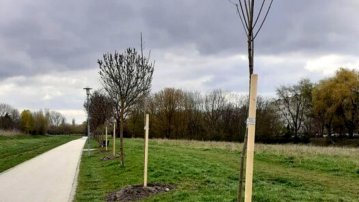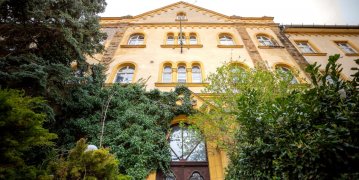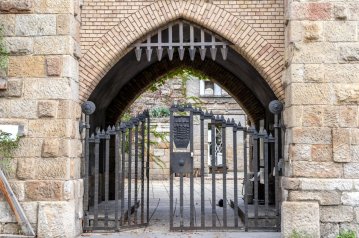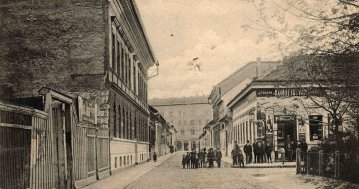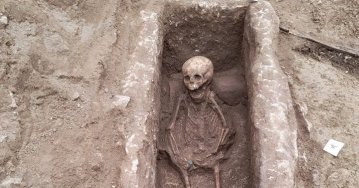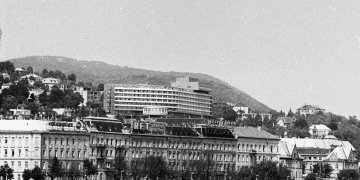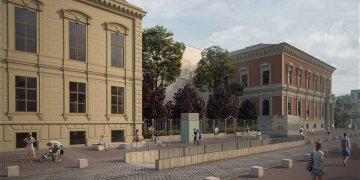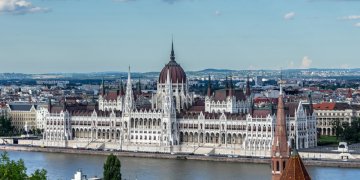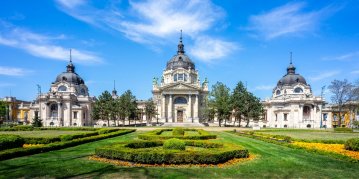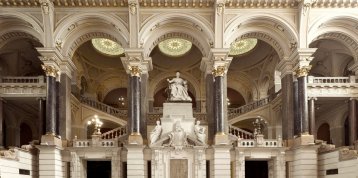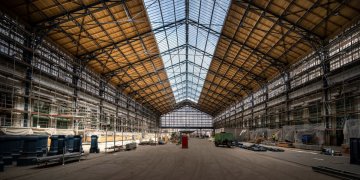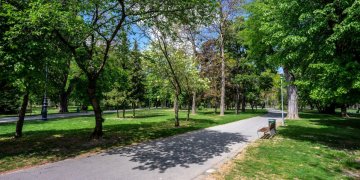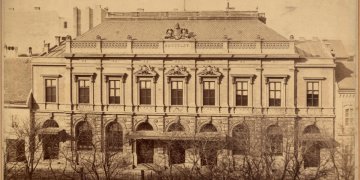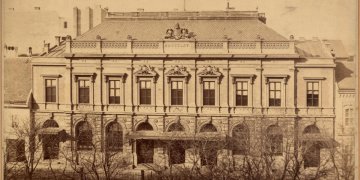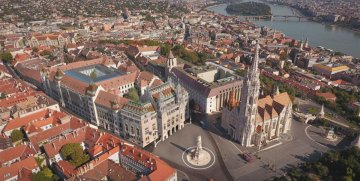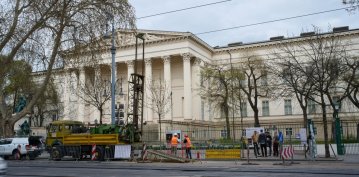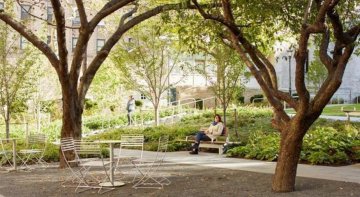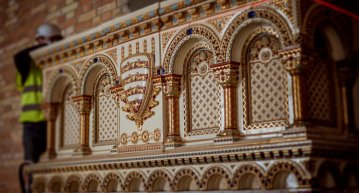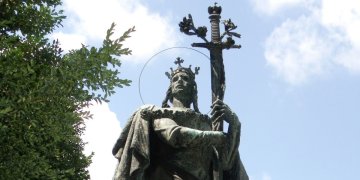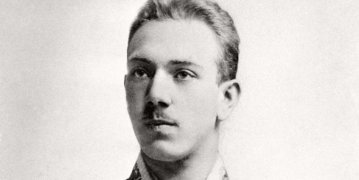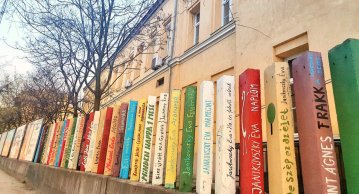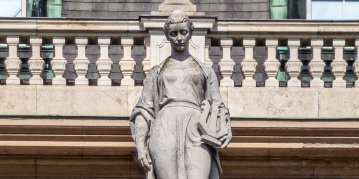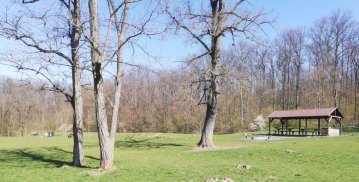 The „intertwined history” of the bridges and the city of Budapest
Which ideas and events have shaped the fate of bridges of Budapest and the cityscape? Alongside many other interesting facts, this question is also answered this newly published book by the Budapest City Archives, which introduces the history of bridges in Budapest.
The „intertwined history” of the bridges and the city of Budapest
Which ideas and events have shaped the fate of bridges of Budapest and the cityscape? Alongside many other interesting facts, this question is also answered this newly published book by the Budapest City Archives, which introduces the history of bridges in Budapest.
Search result
Celebrating the millennial past of the Hungarian nation
May 1, 2021 at 4:00 PM
The central event of the millennium celebrations of 1896, held on the anniversary of the Hungarian Conquest of the Carpathian Basin, was the National Millennium Exhibition held in City Park. The exhibition, which was open for half a year, offered insight into the past of Hungarians and provided an opportunity to present the results achieved during the extraordinary economic development after the Austro-Hungarian Compromise.
Royal Palace of Buda Castle reopens with new guided walk and Hauszmann exhibition
May 1, 2021 at 2:00 PM
Cultural life has returned to the Royal Palace. A new, free exhibition entitled The Hauszmann Story presents the rebirth of the Buda Castle District. Visitors are also invited on a spectacular, underground adventure walk as part of the Buda Castle Walks.
Missing inscription to return to the facade of Palace of Justice
April 30, 2021 at 2:00 PM
A Latin inscription once proclaimed the judicial role of the building that stands opposite the Parliament building on Kossuth Square. Until 1949 the Palace of Justice housed the Curia, Hungary's highest court of appeal. The inscription was removed in the 1950s. During the building's renovation and the relocation of the Curia, the original inscription will return after seventy years.
Second life for the bridges of Budapest?
April 30, 2021 at 9:00 AM
Recently, an announcement was published about reusing the pieces of the soon-to-be-demolished Southern Railway Bridge in Budapest for other, smaller bridges, such as connections to Hajógyári Island. At first glance, it sounds like a rather strange idea to create a new bridge from a used one, but it is not uncommon at all, even in Budapest. There are several bridges in the capital, the elements of which were once parts of other structures.
The last swamp in Buda may become an eternal forest
April 29, 2021 at 6:30 PM
A questionnaire is being used to assess people's position on the development of the last swampy area of Buda, the protected Mocsárosdűlő. The Budapest City Council hopes to create an eternal forest by planting native tree species in the area. The council is waiting for opinions primarily on the function of the area by 5 May.
The imposing palace of Vörösmarty Square – Headquarters of the world-famous Haas Fülöp & Sons Company
April 29, 2021 at 9:00 AM
Fülöp Haas founded the most high-quality carpet manufacturer in the age of dualism in Vienna. The company, which later became world-famous, had two factories in Hungary and a central department store and warehouse in Budapest: one of the most beautiful palaces of today's Vörösmarty Square. The company, which made the production of carpets an applied art, also made the ornate wall tapestry of Saint Stephen Hall in the Royal Palace of Buda Castle, which will soon be reborn in the reconstruction.
Work continues on Millenáris – Reconstruction of Reception Hall begins
April 28, 2021 at 6:00 PM
The renovation of the Reception Hall and the Main Hall of the former Ganz factory on Millenáris Park has begun. The buildings will host community venues and exhibition spaces. The park will host the Álmo Álmodói – Világraszóló magyarok 2.0 ('Dreamers of Dream – Internationally renowned Hungarians') exhibition to celebrate the 20th anniversary of the park's opening.
Budapest is home to one of the oldest veterinary training institutions in Europe
April 28, 2021 at 2:30 PM
The building complex of the University of Veterinary Medicine Budapest has been serving Hungarian veterinary training for exactly 140 years. The building complex in Erzsébetváros, located between today's Rottenbiller and Bethlen Streets, was designed by Imre Steindl, decorated with Zsolnay majolica and stained glass by Miksa Róth. On the World Day of Veterinarians, 28 April, PestBuda presents the history and building complex of the University of Veterinary Medicine Budapest.
The statue of Marx and Engels inaugurated fifty years ago
April 28, 2021 at 12:00 AM
The theoretical foundations of communism were laid by a German philosopher and a wealthy German merchant. Neither of them were workers, yet they hatched plans for a perfect state of workers. In addition to Lenin, socialism considered Marx and Engels to be the “apostles” of the system. Their portraits hang in all the most notable places and events, yet a statue of the two founders was only erected in Budapest relatively late, in 1971 on Jászai Mari Square.
Nagyvásártelep reborn – Winning plans announced
April 27, 2021 at 6:30 PM
A Hungarian architectural firm won the international tender announced for the reconstruction of the Nagyvásártelep area in the 9th District. Designed by Aladár Münnich and built in 1932, the 247-meter-long and 42-meter-wide hall will be reborn as event spaces, sports halls, cafes and clubrooms on three levels, according to the plans of BIVAK Stúdió, as part of the Budapest Diákváros (Student City) development.
Foundations gain ownership of Váry Szabó Mansion and Csillebérc Camp
April 27, 2021 at 3:30 PM
Today, the Parliament passed a bill on the transfer of state real estate. The Foundation for Educational, Cultural and Scientific Education (Polgári Művelődésért, Oktatási, Kulturális és Tudományos Alapítvány) will receive the Váry Szabó Mansion, while the organisers of the Erzsébet Camps will receive the 46 hectare plot of the former Csillebérc Pinoeer Camp.
Renewal in Pasarét: renovation of the Franciscan church and the new parish building to be completed in the autumn
April 27, 2021 at 9:30 AM
The life of one of the first modern churches in Budapest may soon be given new impetus: the investment on Pasaréti Square, next to the church designed by Gyula Rimanóczy and completed in 1934, has begun. The project will renew the parish building, create an up-to-date library and community centre that follows the style of the modern church. Due to the works, the 2nd District church will be closed in July-August, the reconstruction is expected to be completed by Autumn.
Reconstruction of the Charity Hospital continues – The new towers are almost ready
April 26, 2021 at 2:00 PM
Reconstruction works underway since 2019 in the Mazsihisz Charity Hospital (Szeretetkórház) have continued with the renovation of block no. 2. The future central building will house outpatient care and a 60-bed rehabilitation department. Work is expected to be finished next year. The new tower of the unique building on Amerikai Road is already visible and will be completed within weeks.
The home of 5 lakes - Ten interesting pictures of the 250-year-old Füvészkert
April 26, 2021 at 9:00 AM
It has been operating in its current location for 174 years, its oldest trees, the fern pines, have lived through 200 springs, and its fairy roses were admired by members of the royal family. In its area, which once was the park of Festetics Palace, there were once 5 lakes, and its glasshouse was known to generations from The Paul Street Boys. Take an imaginary walk in the 250-year-old Füvészkert (ELTE Botanical Garden; 'herb garden') with ten carefully selected pictures.
Trees replanted in Csepel
April 25, 2021 at 4:00 PM
The replacement trees in the Csepel Open-Air Baths in underway. The aged, diseased willow trees are being cut down, but have been replaced beforehand. In recent years, Csepeli Városgazda Közhasznú Nonprofit Zrt. has planted forty trees and is planning further afforestation.
Renovated gymnasium to be returned to Árpád Secondary School in Óbuda
April 24, 2021 at 2:00 PM
The renovation of Óbuda Árpád Secondary School's gymnasium is progressing well. Through the investment, the school will regain its former large gymnasium, which was given to the Ottó Bláthy Polytechnic in 1965 and converted into a lecture hall. The school was left with a smaller gymnasium.
Outdoor exhibition at the Military History Museum
April 23, 2021 at 4:30 PM
War correspondent units were established in the Hungarian Royal Army in 1941 to document the war. The Military History Institute and Museum has organised an exhibition of their photographs.
Széchenyi cycled for the first time on the banks of the Danube - the postal servants rode velocipedes
April 23, 2021 at 9:00 AM
The first velocipedes on the streets of Pest-Buda caused a great sensation in the late 1860s. By the 1880s, the bicycle had conquered Budapest: associations, cycling schools were formed, social trips, parades and competitions were organized. The capital's postal servants rode velocipedes, and the army also used the vehicles. A World Cycling Championship was also held in the capital. In 1928 the Millenáris Velodrome was the most modern and fastest cycling track in Europe.
A new Citadel rises – Parks and terraces for visitors
April 22, 2021 at 3:00 PM
After the archaeological excavations, the reconstruction of the Citadel and its immediate surroundings has begun. Design renders show that the walls of the former fortress are to be opened in several places. New lookout terraces and will be created in the fortress and courtyard. The investment will be completed by 2023.
Visitor centre planned for Jókai kert – Steindl Villa to host exhibitions
April 21, 2021 at 4:00 PM
The Jókai Garden and the Steindl Villa on Sváb Hill are to be renovated. The investment is planned to be completed by 2022, and the developers hope that Budapest will be enriched with a popular resting place.
Meggyfa Street playground completed
April 21, 2021 at 1:00 PM
The pavements of the playground on Meggyfa Street have been renovated, the missing elements of the fence replaced, new benches and a drinking fountain have been installed, while new trees and plants were planted in the area.
Trees planted along Rákos Stream
April 20, 2021 at 6:00 PM
Ash trees, rowan trees and maples have been planted along the Rákos Stream by the Rákosmente local council. The new plants replaced damaged trees along the cycle path.
Nurse housing and training centre to be created in former Budagyöngye Hospital
April 20, 2021 at 3:00 PM
The Budagyöngye Hospital, which closed in 2007, will be renovated. The building will also regain its original function, with a church-run home for nurses and a training centre. Construction work is scheduled to begin next year.
First housing blocks in Újpalota completed 50 years ago
April 20, 2021 at 9:00 AM
One of the largest housing estates in Budapest can be found in Újpalota, the first apartment of which was completed over 50 years ago, in the spring of 1971. 12,752 apartments were planned originally, but 15,500 were completed by the second half of the 1970s. An average of 5 people lived in each of the 15th District's prefabricated flats.
ICOMOS award caring for the Jewish cemetery on Salgótarjáni Street
April 19, 2021 at 2:00 PM
The Hungarian National Committee of ICOMOS awarded the National Heritage Institute for the restoration, maintenance of the Jewish Cemetery on Salgótarjáni Street and its presentation to the public on World Monument Day. The National Heritage Institue was lauded in the Exemplary Monument Care category.
No place to call home – József Attila's family moved every six months
April 19, 2021 at 10:00 AM
Ferencváros, including Ferenc Square, was where one of the greatest figures of Hungarian poetry, Attila József, lived from his birth until the age of 14. His father, Áron József, abandoned the family in 1908, when the youngest child, Attila, was three years old. Despite having moved a lot before, his mother, Borbála Pőcze, was forced to find a new home almost every six months due to being behind on their rent.
Archaeologists unearth remains of Roman child during dig near Bécsi Road
April 18, 2021 at 2:00 PM
A grave from the late Roman era has been excavated on a construction site near Kolosy Square in Óbuda, in the former cemetery of the Military City Aquincum. The tomb housed the remains of a small child who was once buried with pots and coins, and a headrest made of tiles was placed under his head.
The SZOT Resort on Rózsadomb opened 50 years ago – Cable-car for guests never completed
April 18, 2021 at 9:30 AM
One of the most controversial buildings in Budapest, the SZOT Resort on Rózsadomb, has been part of the cityscape for half a century. The huge 114-meter-long building of the health resort once accommodated up to 500 guests at a time, who were transported to the nearby Lukács Baths by a minibus. Contrary to the original plans, neither a cable car nor a lift was built. The gigantic house later stood empty for decades, but today it has been reborn as a luxury residential building.
Renders released – Budapest campus of Pázmány Péter University to open in 2027
April 17, 2021 at 2:00 PM
The campus of the Pázmány Péter Catholic University planned to use the former buildings of the Hungarian Radio will significantly change the cityscape. During the investment, which is expected to be completed by 2027, several significant buildings will be renovated in the area behind the National Museum, such as the Esterházy Palace, which also includes the former Marble Hall of the National Radio and the dilapidated Károlyi Palace. New buildings will also be erected.
The iron founder Ignác Schlick was born 200 years ago – His Factory built the Dome of the Parliament Building
April 17, 2021 at 10:00 AM
The factory he founded played an indispensable role in the development of the Hungarian capital, as he made the iron structures of many emblematic buildings: the dome of the Parliament, the Opera House and the Hungarian Academy of Arts and the Museum of Applied Arts, as well as the glass-iron facade curtain walls of the Nyugati (Western) and Keleti (Eastern) railway stations. The Deák statue in Széchenyi Square was also made in his foundry. Although Ignác Schlick may be known to a few, his work is often forgotten in the development of Budapest.
Dismantled historic changing cabins at Széchenyi Baths to be rebuilt
April 16, 2021 at 5:00 PM
The restoration of the changing cabins built during the 1927 expansion of the baths, which were demolished without a permit at the beginning of 2020, will be rebuilt.
Statue of Justitia returning to Kossuth Square
April 16, 2021 at 2:30 PM
The 1896 marble statue of the Roman goddess of justice, Justitia, by Alajos Strobl, is returning to its original place after 71 years. The statue is being moved from the building of the Curia on Markó Street to the Palace of Justice opposite the parliament building. The building designed by Alajos Hauszmann on Kossuth Square, which previously housed the Museum of Ethnography, is being returned to the Curia. The palace is thus being renovated, and the facades and monumental interiors will regain their former beauty.
Renovation of Nyugati Railway Station to be completed by September
April 16, 2021 at 12:30 PM
Plaster repairs are currently underway in the Nyugati Railway Station as other parts of the facade are being painted. The doors and windows will be modernised, and the clocks on the glass walls towards Teréz körút and the facade on Eiffel Square will also be renewed. The renovation of the towers towards the track entrance has been completed. The decorative windows have been installed, and the old artificial slate covering has been replaced with a natural anthracite slate. The crown on the boulevard facade of the railway station was also repainted in the same colour as the steel structure of the roof. Passengers will return to the hall in September.
Jókai's loyal readers - Reading Girls, a statue by Alajos Strobl to return to Jókai Square
April 16, 2021 at 9:30 AM
Not only books, but sculptures also have their own destiny – this is what comes to mind when looking at the plans for the renovation of Jókai Square in Terézváros. In the shadow of Mór Jókai's sculpture erected in 1921, a smaller work appears, which may be familiar to many from among the trees of Városliget. The statue of the Reading Girls was originally intended by the creator Alajos Strobl as a side figure of the Jókai statue in Jókai Square but was never erected on the square. The Reading Girls statue was erected in 1929 but will now be moved from Városliget to its originally intended location.
Green space developments to increase in second half of the decade
April 15, 2021 at 5:00 PM
Pestbuda has studies the Budapest Green Infrastructure Development and Maintenance Action Plan recently adopted by the Budapest General Assembly in detail. The document called the Dezső Radó Plan is essentially a summary of the green area developments in Budapest that have previously been decided at a government, district or city level. Several of them have already started and are in progress, and there are some new elements in the recently released plans.
Lanchid renovation – Pedestrian underpass in Pest closed
April 15, 2021 at 2:30 PM
The pedestrian underpass on the pest side of the river bridge will be closed on 16 April. The passage on the Buda sie will remain open until mid-June. Both pedestrian underpasses are to be widened as part of the renovation. While footpaths across the bridge are also closed, buses are free between Clark Ádám Square and Széchenyi Square. The reconstruction of the bridge is planned to last until 2023.
Members moved to the Former House of Representatives 155 years ago
April 15, 2021 at 10:30 AM
Two buildings in Pest were built for the national assembly. It is well-known that the vast Parliament Building on the Danube banks, completed in 1902, is one of the largest buildings in the world, houses the National Assembly. However, the Neo-Renaissance palace, the Former House of Representatives in Bródy Sándor Street, designed by Miklós Ybl, which elected members began using 155 years ago, is older than its grand sister.
Visible work on exterior of Ministry of Finance building begins
April 14, 2021 at 7:30 PM
The monumental reconstruction of the facade and roof structure of the Ministry of Finance on Szentháromság Square and the restoration of the representative interiors is to begin soon. The building, which will be completed by 2023, will follow the designs Sándor Fellner created.
Construction of metro line 5 begins – First boreholes drilled
April 14, 2021 at 6:00 PM
To prepare the plans for the planned tunnel between Közvágóhíd and Kálvin tér, the Budapest Development Center will start drilling boreholes for soil tests at 93 locations. Work started first on Kálvin Square. The extension of the suburban railway lines to Csepel and Ráckeve to Kálvin tér and the construction of metro line 5 will connect the southern parts of Budapest to the city centre more efficiently.
Klauzal Square to be renovated with Ghetto memorial
April 14, 2021 at 3:30 PM
The 7th District Local Council has announced a design tender for a public memorial to be erected on the renovated Klauzál Square. The future memorial site planned to be inaugurated in 2022 will memorialise the Pest ghetto, which once included Klauzal Square.
Zsolnay fireplace in Saint Stephen's Hall now being built
April 14, 2021 at 12:30 PM
The largest Zsolnay fireplace in the country, weighing nearly one and a half tons, is now being built in the Saint Stephen's Hall of the Royal Palace of Buda Castle. Hungarian artisans, including representatives of disappearing crafts, took part in the re-creation of the 611-piece ceramic fireplace. The historical hall will be open to the public on August 20.
The cult of Saint Emeric of Hungary – The 18th District stands in memory of the Prince
April 14, 2021 at 10:30 AM
Hungary celebrated the life of Saint Emeric, the son of the country's first King, Saint Stephen, 90 years ago. On the 900th anniversary of the death of Prince Emeric (Imre), who was consecrated together with his father in 1083, a large-scale memorial year was organized in 1930–1931 and the village of Pestszentimre was named after him, which in 1950 became part of the 18th District of Budapest. The church in the district also bears the name of the prince, and the first public statue of the district also depicts Saint Emeric.
Budapest may become World Book Capital for the 150th anniversary of the unification of Buda and Pest
April 13, 2021 at 6:00 PM
Budapest will submit a bid for the title of World Book Capital 2023 to UNESCO on 15 April. In the event of a successful application, cultural programs promoting books and reading will be organised throughout Budapest for a year.
Alfréd Hajós, Hungary's first Olympic champion, learned to swim on the Danube section in front of the Parliament
April 13, 2021 at 9:00 AM
As an outstanding talent, Alfréd Hajós created something unique in many sports and his chosen profession, architecture. He won the first Olympic champion title for Hungary when 125 years ago; in addition to the 100-meter sprint, he also won the 1,200-meter race in the sea-swimming competition held on 11 April 1896, near Athens. As an architect, he designed, among others, the National Sports Swimming Pool on Margit Island and the synod headquarters of the Reformed Church in Zugló.
Fence of Bethesda Children’s Hospital transformed into books
April 12, 2021 at 2:30 PM
The fence of Bethesda Children's Hospital has been recreated: the previously grey concrete elements overlooking Hungária Boulevard have been repainted. The fence is now reminiscent of a huge bookshelf with many colourful children's books, from classics to contemporary authors.
The longest monuments in Budapest: the history of the embankments
April 12, 2021 at 9:30 AM
Until the middle of the 19th century, anyone could walk down to the undeveloped, muddy banks of the Danube, but during a flood, nothing stood in the way of the water. The 12-kilometre-long embankments along Budapest's Danube Banks have become an essential part of the cityscape and protect the capital from floods. In connection with the freshly announced reconstruction of the Pest embankment, Pestbuda presents the history of these magnificent structures.
Jókai Square in Terézváros to be renovated
April 11, 2021 at 6:00 PM
Jókai Square in the 6th District will be renovated over the summer. An orderly park is planned with a reading corner, pergola and lots of seating. Plants and flower beds are to be planted, and a stage will be added to host cultural events.
65 years of National Poetry Day – Sculptures in Budapest pay tribute to poetry
April 11, 2021 at 12:00 PM
For the second year in a row, the country is celebrating National Poetry Day behind closed doors. After last year's tour of statues, when Pestbuda visited the monuments of famous poets, we now showcase several works depicting poetry itself on Budapest's famous buildings.
A Chamber of adventures in Budapest – Kamaraerdő holds excitement for everyone
April 10, 2021 at 12:00 PM
Join Pestbuda on a visit to the largest contiguous forest in the most populous district of Budapest. It is a forest, but it could be called an adventure since there are no other places in Budapest with so many leisure activities.
Square near Nyugati Railway Station named after Béla Puczi
April 8, 2021 at 7:30 PM
The part of Nyugati Square right next to the railway station has newly been named after Béla Puczi, who led Gypsies to defend the Hungarians during the anti-Hungarian pogrom in Târgu Mureş in 1990.
 The „intertwined history” of the bridges and the city of Budapest
Which ideas and events have shaped the fate of bridges of Budapest and the cityscape? Alongside many other interesting facts, this question is also answered this newly published book by the Budapest City Archives, which introduces the history of bridges in Budapest.
The „intertwined history” of the bridges and the city of Budapest
Which ideas and events have shaped the fate of bridges of Budapest and the cityscape? Alongside many other interesting facts, this question is also answered this newly published book by the Budapest City Archives, which introduces the history of bridges in Budapest.
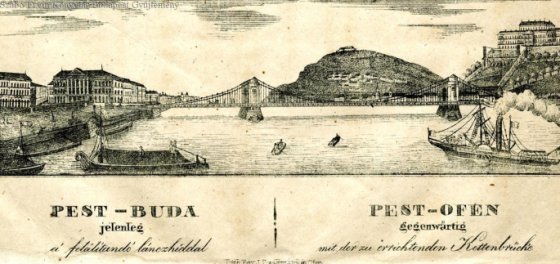 The Bridge Report, which brought a turning point in the history of Budapest
A travel report that changed the history of Pest and Buda, as well as Hungary. The little book contributed to the change of half a thousand years of legal customs and the implementation of an investment of unprecedented size and technical quality. This book was The Bridge Report [Hídjelentés in Hungarian].
The Bridge Report, which brought a turning point in the history of Budapest
A travel report that changed the history of Pest and Buda, as well as Hungary. The little book contributed to the change of half a thousand years of legal customs and the implementation of an investment of unprecedented size and technical quality. This book was The Bridge Report [Hídjelentés in Hungarian].
 Drama on the university wall - The heroic monument was planned 95 years ago
In the constant hustle and bustle of the Egyetem Square in Pest, the students may not even notice the monument that decorates the short section of wall between the church and the central building of ELTE. However, it commemorates their predecessors, the heroes who fought for their country in World War I, and those who heroically helped them. The first design of the dramatically collapsing soldier was born in 1928, ninety-five years ago.
Drama on the university wall - The heroic monument was planned 95 years ago
In the constant hustle and bustle of the Egyetem Square in Pest, the students may not even notice the monument that decorates the short section of wall between the church and the central building of ELTE. However, it commemorates their predecessors, the heroes who fought for their country in World War I, and those who heroically helped them. The first design of the dramatically collapsing soldier was born in 1928, ninety-five years ago.

